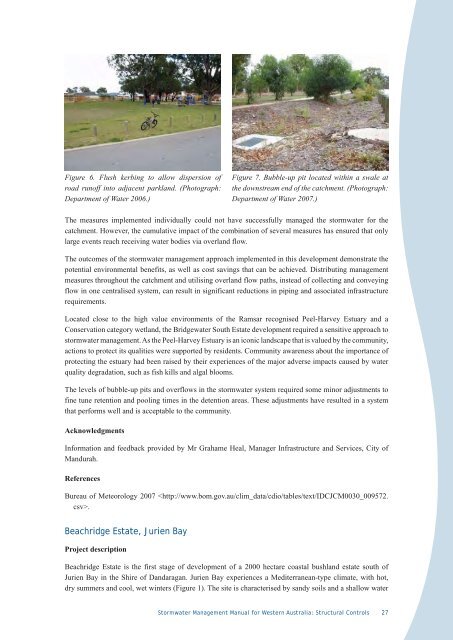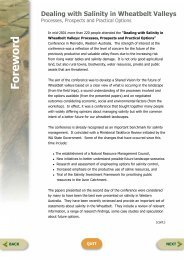9Structural Controls - Department of Water - The Western Australian ...
9Structural Controls - Department of Water - The Western Australian ...
9Structural Controls - Department of Water - The Western Australian ...
Create successful ePaper yourself
Turn your PDF publications into a flip-book with our unique Google optimized e-Paper software.
Figure 6. Flush kerbing to allow dispersion <strong>of</strong><br />
road run<strong>of</strong>f into adjacent parkland. (Photograph:<br />
<strong>Department</strong> <strong>of</strong> <strong>Water</strong> 2006.)<br />
<strong>The</strong> measures implemented individually could not have successfully managed the stormwater for the<br />
catchment. However, the cumulative impact <strong>of</strong> the combination <strong>of</strong> several measures has ensured that only<br />
large events reach receiving water bodies via overland flow.<br />
<strong>The</strong> outcomes <strong>of</strong> the stormwater management approach implemented in this development demonstrate the<br />
potential environmental benefits, as well as cost savings that can be achieved. Distributing management<br />
measures throughout the catchment and utilising overland flow paths, instead <strong>of</strong> collecting and conveying<br />
flow in one centralised system, can result in significant reductions in piping and associated infrastructure<br />
requirements.<br />
Located close to the high value environments <strong>of</strong> the Ramsar recognised Peel-Harvey Estuary and a<br />
Conservation category wetland, the Bridgewater South Estate development required a sensitive approach to<br />
stormwater management. As the Peel-Harvey Estuary is an iconic landscape that is valued by the community,<br />
actions to protect its qualities were supported by residents. Community awareness about the importance <strong>of</strong><br />
protecting the estuary had been raised by their experiences <strong>of</strong> the major adverse impacts caused by water<br />
quality degradation, such as fish kills and algal blooms.<br />
<strong>The</strong> levels <strong>of</strong> bubble-up pits and overflows in the stormwater system required some minor adjustments to<br />
fine tune retention and pooling times in the detention areas. <strong>The</strong>se adjustments have resulted in a system<br />
that performs well and is acceptable to the community.<br />
Acknowledgments<br />
Information and feedback provided by Mr Grahame Heal, Manager Infrastructure and Services, City <strong>of</strong><br />
Mandurah.<br />
References<br />
Bureau <strong>of</strong> Meteorology 2007 .<br />
Beachridge Estate, Jurien Bay<br />
Project description<br />
Figure 7. Bubble-up pit located within a swale at<br />
the downstream end <strong>of</strong> the catchment. (Photograph:<br />
<strong>Department</strong> <strong>of</strong> <strong>Water</strong> 2007.)<br />
Beachridge Estate is the first stage <strong>of</strong> development <strong>of</strong> a 2000 hectare coastal bushland estate south <strong>of</strong><br />
Jurien Bay in the Shire <strong>of</strong> Dandaragan. Jurien Bay experiences a Mediterranean-type climate, with hot,<br />
dry summers and cool, wet winters (Figure 1). <strong>The</strong> site is characterised by sandy soils and a shallow water<br />
Stormwater Management Manual for <strong>Western</strong> Australia: Structural <strong>Controls</strong> 27













